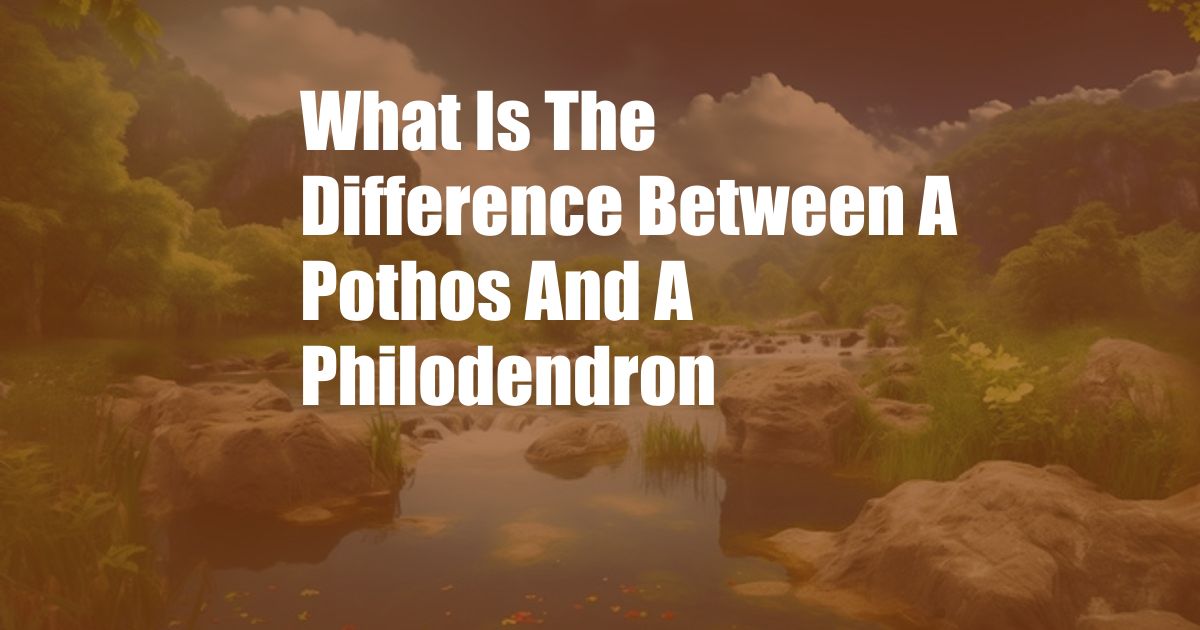
Unveiling the Enigmatic Differences Between Pothos and Philodendrons
As an avid plant enthusiast, I’ve often marveled at the intricate beauty of pothos and philodendrons, two alluring plants that grace homes and offices alike. Their lush, trailing vines and vibrant leaves bestow a touch of nature’s tranquility upon any space. However, beneath their captivating exteriors lie subtle distinctions that warrant exploration.
Embarking on this botanical adventure, let’s illuminate the enigmatic differences between these two verdant wonders.
Taxonomy: Unveiling the Divide
Both pothos and philodendrons belong to the Araceae family, renowned for its diverse array of plants. However, their distinct genus sets them apart. Pothos, scientifically classified as Epipremnum aureum, boasts a wide variety of cultivars, each exhibiting unique leaf patterns and colors. Philodendrons, on the other hand, encompass a vast genus of over 400 species, showcasing an extraordinary range of shapes, sizes, and textures.
More specifically, pothos plants are characterized by heart-shaped leaves. Their petioles, or leaf stalks, feature a distinct sheath that clasps the stem. Philodendrons, on the other hand, exhibit a broader variety of leaf shapes, including arrowhead, oval, and deeply lobed. Their petioles lack the clasping sheath.
Habitat and Growth Patterns
Pothos and philodendrons both thrive in tropical and subtropical environments, preferring warm temperatures and humid conditions. They are both highly adaptable plants that can flourish in a range of lighting conditions, making them ideal for indoor cultivation. However, some species of philodendrons, such as the Philodendron bipinnatifidum, are more tolerant of low light levels than pothos.
When it comes to growth patterns, pothos tends to be a more vigorous climber than philodendrons. Its aerial roots enable it to cling to surfaces, making it an excellent choice for trellises or hanging baskets. Philodendrons, while not as vigorous climbers, have a bushier growth habit, making them suitable for use as groundcovers or in containers.
Expert Advice: Nurturing Your Verdant Beauties
To ensure the flourishing of your pothos and philodendron companions, consider the following expert advice:
Water Wisely: Both plants prefer well-drained soil and moderate watering. Allow the topsoil to dry out slightly between waterings, and avoid overwatering, as it can lead to root rot.
Fertilize Regularly: During the growing season, fertilize your plants monthly with a balanced liquid fertilizer. This will provide them with essential nutrients for optimal growth.
Provide Adequate Sunlight: Pothos and philodendrons prefer bright, indirect light. Avoid placing them in direct sunlight, as it can scorch their leaves.
Control Pests: These plants are generally pest-resistant, but they can occasionally be affected by spider mites or mealybugs. Inspect your plants regularly for signs of infestation and treat promptly with an appropriate insecticide.
Frequently Asked Questions
Q: Are pothos and philodendrons toxic to pets?
A: Yes, pothos and philodendrons are mildly toxic to pets, containing calcium oxalate crystals that can cause irritation to the mouth, throat, and digestive system if ingested.
Q: Can I propagate pothos and philodendrons from cuttings?
A: Yes, both pothos and philodendrons can be easily propagated from stem cuttings. Simply take a cutting with a few leaves and place it in water or moist soil. Roots will develop within a few weeks.
Conclusion
Unveiling the differences between pothos and philodendrons expands our appreciation for the captivating diversity of the plant kingdom. Their distinct characteristics, from leaf shape to growth patterns, provide a unique and versatile canvas for beautifying our homes and connecting with nature. As you embark on your plant-care journey, may this article serve as a guide to nurturing your verdant companions and unlocking the secrets of their flourishing existence.
Are you intrigued by the fascinating realm of pothos and philodendrons? Share your thoughts and experiences in the comments below!